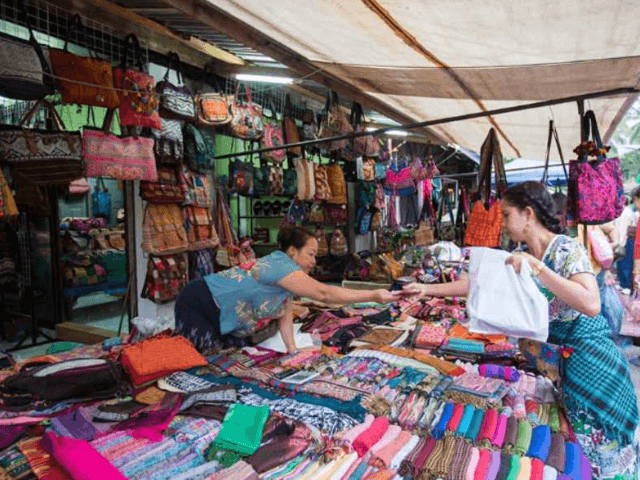The Son Doong cave is rated first on Bored Panda's list of the world's 15 most magnificent caverns. There are also interesting Son Dong cave facts that will make you gasp when you hear. Read on here.
TABLE OF CONTENTS
1
Explore Son Doong Cave - The World's Largest Cave in Vietnam
2
Introduction to Son Doong Cave
Where Is Son Doong Cave Located?
How Was Son Doong Cave Discovered?
What Makes Son Doong the Largest Cave in the World?
3
Why Son Doong Cave Is a Must-Visit Destination
The Breathtaking Underground Jungle & Ecosystem
Gigantic Stalactites & Otherworldly Rock Formations
The Underground River Flowing Through the Cave
4
How to Visit Son Doong Cave?
Permits & Regulations - Why You Need a Guided Tour
Best Tour Operators for a Safe & Exciting Adventure
How Long Is the Son Doong Cave Expedition?
5
The Ultimate Son Doong Cave Trekking Experience
Day-by-Day Itinerary for Exploring Son Doong Cave
Challenges & Physical Requirements for the Trek
What to Expect During the Expedition?
6
Best Time to Visit Son Doong Cave
Weather & Seasonal Conditions in Phong Nha-Ke Bang National Park
Pros & Cons of Different Travel Seasons
7
How to Prepare for the Son Doong Cave Adventure?
Packing List - Essentials for the Expedition
Fitness & Training Tips for First-Time Trekkers
Safety Guidelines & Things to Know Before You Go
8
How Much Does It Cost to Visit Son Doong Cave?
Why Is the Son Doong Cave Tour Expensive?
A Breakdown of the Tour Costs
Alternative Caving Adventures for Budget Travelers
9
Other Must-Visit Caves Near Son Doong
Hang En Cave - The Third Largest Cave in the World
Tu Lan Cave System - A Hidden Gem in Phong Nha
Paradise Cave - A Stunning Alternative for Non-Trekkers
10
How to Get to Son Doong Cave?
Travel Routes from Hanoi & Ho Chi Minh City
Best Ways to Reach Phong Nha-Ke Bang National Park
Where to Stay Before & After the Expedition?
11
Photography Tips for Capturing Son Doong’s Beauty
Best Camera Gear for Cave Photography
Lighting Challenges & How to Overcome Them
Iconic Spots Inside Son Doong for Breathtaking Shots
12
Conclusion - Why Son Doong Cave Should Be on Your Bucket List
A Once-in-a-Lifetime Adventure in Vietnam
Son Doong’s Role in Conservation & Ecotourism
Final Travel Tips for an Unforgettable Experience
Explore Son Doong Cave - The World's Largest Cave in Vietnam
Son Doong Cave, hidden deep within Vietnam's Phong Nha-Ke Bang National Park, is a breathtaking wonder of nature. As the largest cave in the world, it boasts enormous chambers, an underground river, and a thriving rainforest inside. Discovered only recently, this massive underground marvel continues to captivate explorers and adventurers. Join us as we uncover the mysteries of Son Doong, from its discovery to what makes it truly unique.
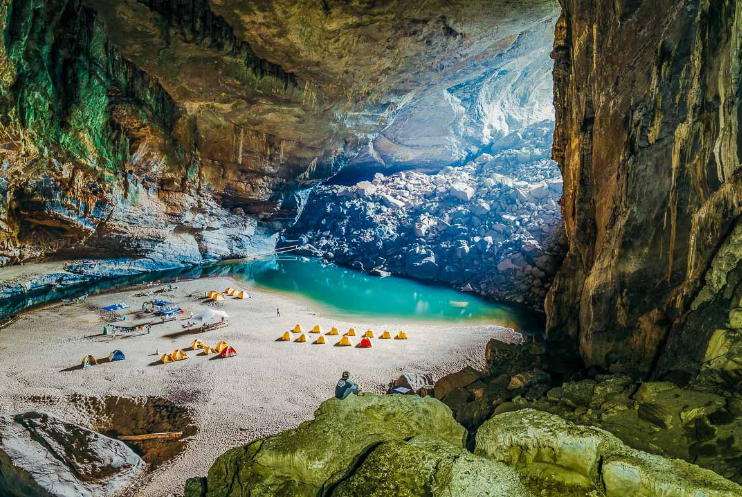
Introduction to Son Doong Cave
Son Doong Cave, located in Vietnam, is the largest cave in the world by volume. Hidden within the dense jungles of Phong Nha-Ke Bang National Park, it remains one of the most breathtaking natural wonders on the planet. Its massive chambers, underground river, and unique ecosystem have captured the imagination of explorers and nature lovers alike. This cave is not only a geological marvel but also a destination that promises an unparalleled adventure for those who seek to uncover the secrets of Earth's underground world.
Where Is Son Doong Cave Located?
Son Doong Cave is situated in Phong Nha-Ke Bang National Park, a UNESCO World Heritage Site in Quang Binh Province, central Vietnam. The national park is known for its stunning karst landscapes, extensive cave systems, and rich biodiversity. The cave itself lies deep within the jungle, accessible only via an organized expedition. Due to its remote location, reaching Son Doong requires a multi-day trek through the park, making the journey as exciting as the destination itself.
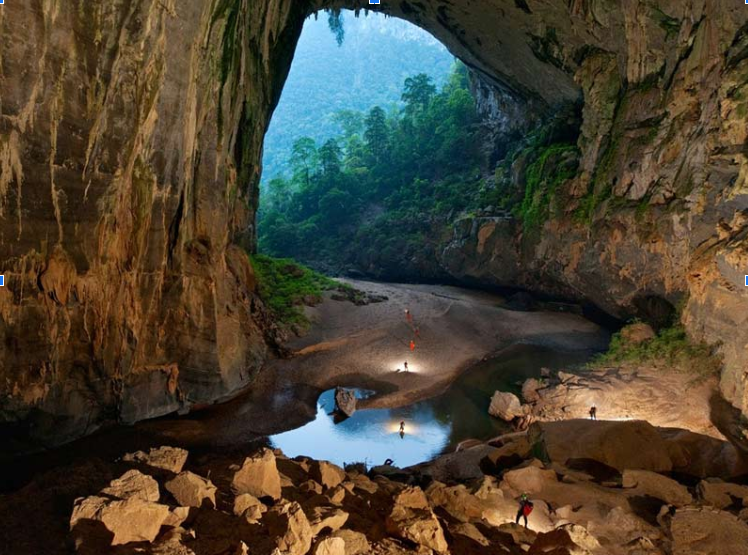
How Was Son Doong Cave Discovered?
The existence of Son Doong Cave was first known to local residents, but it wasn't until 2009 that it gained global recognition. A local man named Ho Khanh stumbled upon the cave entrance in 1991 while seeking shelter from a storm. However, he lost track of its location for years. In 2009, he rediscovered it and led a team of British cave experts, led by Howard Limbert, to explore it. What they found was astonishing: a cave so vast that it could house an entire city block with skyscrapers. This discovery turned Son Doong into an international sensation and a must-visit destination for adventurers worldwide.
What Makes Son Doong the Largest Cave in the World?
Son Doong Cave holds the title of the world's largest cave based on its cross-sectional volume. It stretches over 9 kilometers (5.6 miles) long, with sections reaching up to 200 meters (656 feet) high and 150 meters (492 feet) wide. To put this into perspective, its largest chamber could fit an entire Boeing 747 with room to spare.
Beyond its sheer size, Son Doong is famous for its unique features. The cave houses an underground river, giant stalagmites reaching over 70 meters (230 feet) tall, and massive cave pearls formed over thousands of years. One of its most extraordinary aspects is the presence of two large dolines—collapsed sections of the ceiling that allow sunlight to filter in. This natural skylight has created a thriving underground rainforest, making Son Doong one of the few caves in the world with its own ecosystem.
Son Doong Cave remains a hidden gem due to its limited access. Only a few hundred visitors are permitted to explore it each year through guided tours, ensuring its preservation while offering a once-in-a-lifetime adventure. Whether you're an avid explorer or simply fascinated by the wonders of nature, Son Doong Cave stands as a testament to the incredible beauty hidden beneath our feet.
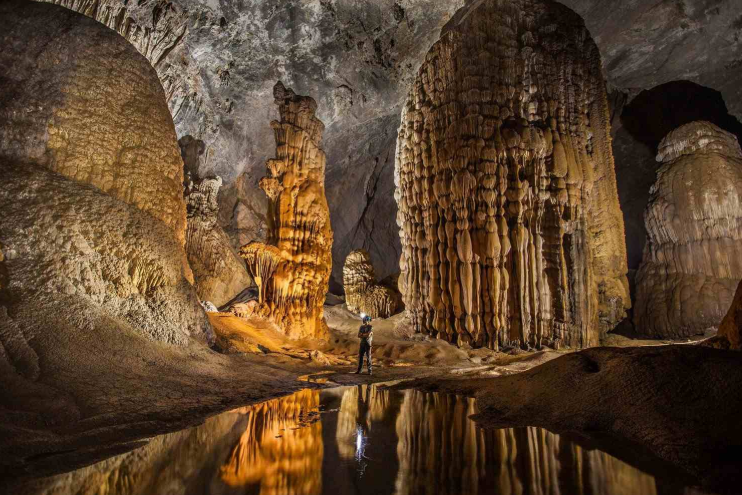
Why Son Doong Cave Is a Must-Visit Destination
Son Doong Cave is not just a geological marvel; it is an adventurer’s dream and a natural wonder that remains largely untouched by human influence. From its otherworldly underground jungle to the towering rock formations sculpted over millions of years, every step inside Son Doong offers an unparalleled experience. Here’s why this awe-inspiring cave is a bucket-list destination for nature lovers and thrill-seekers alike.
The Breathtaking Underground Jungle & Ecosystem
One of the most extraordinary features of Son Doong Cave is its underground jungle, which exists due to massive dolines-natural sinkholes formed when sections of the cave ceiling collapsed. These dolines allow sunlight to penetrate deep into the cave, creating an environment where trees and other vegetation flourish. Towering ferns, moss-covered rocks, and even small animals thrive in this isolated ecosystem, making it one of the few places on Earth where a jungle exists entirely underground.
The jungle within Son Doong creates a surreal, almost prehistoric atmosphere. Mist rises from the lush greenery, and the interplay of light and shadow enhances the mystical beauty of the surroundings. This microclimate is home to rare plant species and creatures such as insects and small mammals that have adapted to the cave’s unique conditions. Walking through this underground paradise is like stepping into a hidden world untouched by time.
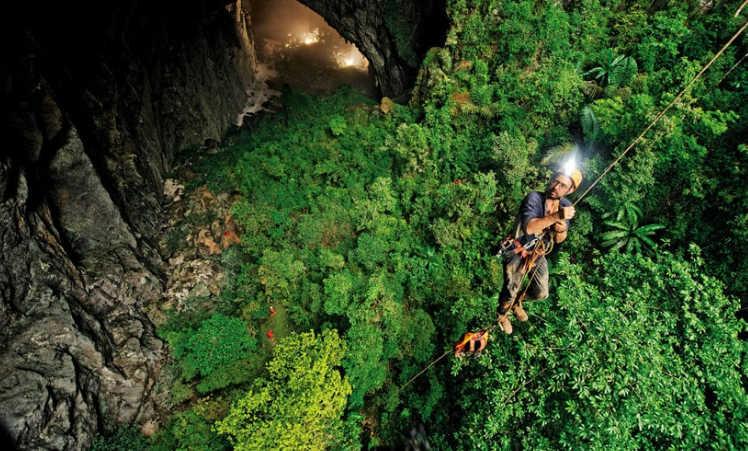
Gigantic Stalactites & Otherworldly Rock Formations
Son Doong is home to some of the largest stalactites and stalagmites on the planet, formed drop by drop over millions of years. Some of these rock formations tower over 70 meters (230 feet) tall—higher than a 20-story building. The sheer scale of these structures is overwhelming, making visitors feel as if they have entered an alien world.
Among the cave’s most iconic formations is the “Hand of Dog”, a massive stalagmite resembling a giant’s hand reaching toward the ceiling. There are also countless flowstones, cave pearls, and unique rock shapes sculpted by water and time, creating landscapes that seem straight out of a science fiction movie. Some formations take on shapes resembling mythical creatures, further adding to the cave’s enchanting allure. The mineral deposits in the cave give some of these formations striking colors, from deep emerald to shimmering white, enhancing the visual spectacle.

The Underground River Flowing Through the Cave
At the heart of Son Doong lies an underground river, which has been slowly carving the cave’s passageways for millions of years. This subterranean waterway, with its crystal-clear pools and winding currents, is one of the most striking elements of the cave’s landscape. The presence of water not only contributes to the cave’s breathtaking scenery but also sustains its unique ecosystem.
In some sections of the cave, the river forms deep blue pools, reflecting the cavern’s towering walls and adding to its dreamlike atmosphere. During certain times of the year, explorers must navigate through sections of the cave by boat, making the journey even more exhilarating. The sound of flowing water reverberates through the cave’s vast chambers, enhancing its mystical, almost sacred ambiance.
Son Doong Cave is more than just a destination-it is an unparalleled journey into one of the last great wildernesses on Earth. With its colossal chambers, vibrant underground jungle, and mesmerizing geological formations, every moment spent in this hidden world is an adventure of a lifetime.
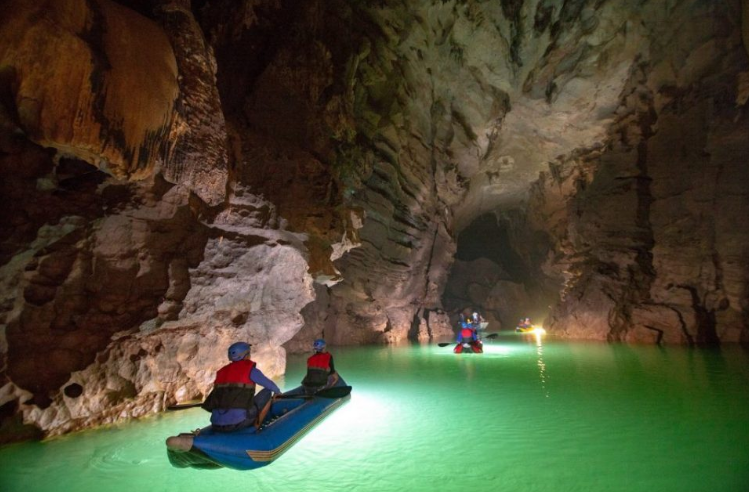
How to Visit Son Doong Cave?
Permits & Regulations - Why You Need a Guided Tour
Visiting Son Doong Cave is a once-in-a-lifetime experience, but due to its delicate ecosystem and challenging terrain, independent visits are not allowed. The Vietnamese government strictly regulates access to the cave to preserve its natural beauty and protect visitors. A limited number of permits are issued each year, ensuring that tourism does not negatively impact the cave’s fragile environment.
All visitors must join a guided tour led by licensed experts. These tours include experienced guides, porters, and safety personnel who assist with navigation and ensure visitors adhere to environmental protection guidelines. The exclusivity of the permits and the requirement for guided expeditions make a visit to Son Doong a rare and highly sought-after adventure.
Best Tour Operators for a Safe & Exciting Adventure
Given the complexity of the journey, choosing a reputable tour operator is crucial. The only official company authorized to run expeditions to Son Doong is Oxalis Adventure, a highly respected operator known for its expertise and commitment to sustainable tourism.
Oxalis Adventure offers a comprehensive expedition package that includes professional guides, necessary equipment, porters to carry supplies, and strict safety protocols. Their tours emphasize responsible exploration, ensuring that the cave remains pristine for future generations. Booking well in advance is essential, as spots fill up quickly due to the limited number of permits available each year.
How Long Is the Son Doong Cave Expedition?
A typical Son Doong expedition lasts about four to six days, depending on the itinerary. The journey is physically demanding and requires participants to trek through dense jungle, traverse rivers, and descend into the massive cave chambers.
Each day of the expedition brings new challenges and breathtaking sights. Trekkers camp inside the cave, explore different sections, cross underground rivers, and witness the astonishing landscapes that make Son Doong a world-renowned wonder. The entire experience requires a good level of fitness, as participants will need to hike for several kilometers daily while carrying personal gear.
Despite the physical demands, the reward is unparalleled—a chance to step into a world hidden beneath the Earth’s surface, where nature’s beauty remains untouched and time seems to stand still. For those seeking the ultimate adventure, a journey through Son Doong Cave is truly an experience of a lifetime.
The Ultimate Son Doong Cave Trekking Experience
Son Doong Cave is not just a place to visit; it’s an expedition that tests endurance, rewards curiosity, and immerses adventurers in one of the most spectacular natural wonders on Earth. This once-in-a-lifetime journey requires preparation, physical fitness, and a willingness to embrace the unknown.
Day-by-Day Itinerary for Exploring Son Doong Cave
A standard Son Doong expedition lasts about six days, including the trek to and from the cave. Each day presents new challenges and breathtaking scenery.
Day One: Arrival & Jungle Trek to Hang En Cave
The adventure begins in Phong Nha, where trekkers meet the guides, porters, and safety team. After a briefing, the trek starts through dense jungle, crossing rivers and rough terrains. The first stop is Hang En Cave, the third-largest cave in the world, where explorers camp overnight.
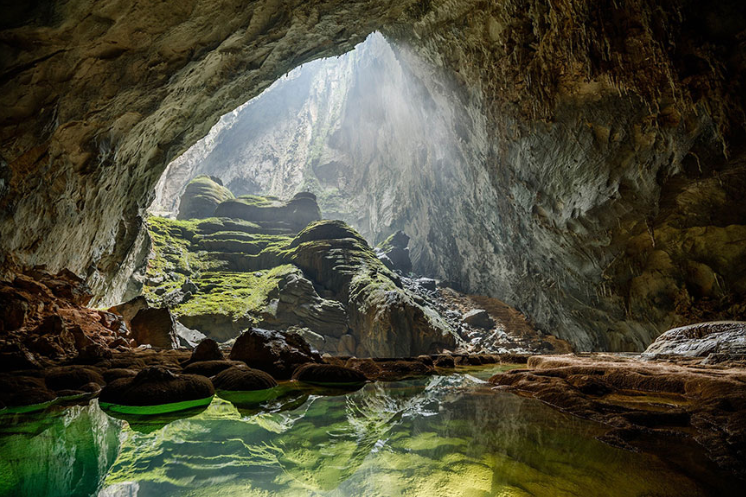
Day Two: Entering Son Doong Cave
A challenging hike through the jungle leads to the entrance of Son Doong. A 90-meter descent marks the thrilling first step into the world's largest cave. Inside, the first sights include gigantic chambers, prehistoric-looking landscapes, and surreal rock formations.
.png)
Day Three: The Underground Jungle & Fossil Passage
A trek through massive dolines (collapsed ceilings) reveals Son Doong’s unique underground jungle. Sunlight filters through, supporting lush greenery and an ecosystem found nowhere else. Explorers pass through fossilized coral formations, remnants of an ancient ocean that once covered the region.
Day Four: The Great Wall of Vietnam
A challenging climb leads to one of Son Doong’s most famous features: The Great Wall of Vietnam, a 60-meter-high calcite barrier. Using safety ropes and ladders, adventurers ascend to the top to witness breathtaking views of the cavernous expanse. Camps are set up near the wall, offering one of the most surreal camping experiences in the world.
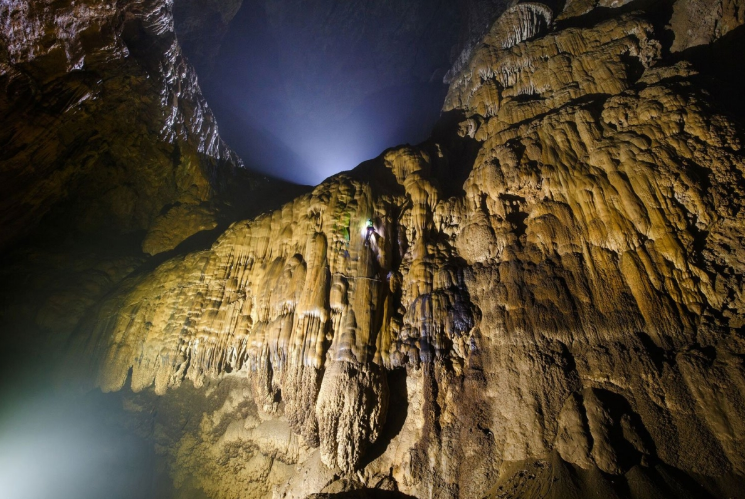
Day Five: Exiting the Cave & Returning to Civilization
The descent back through Son Doong provides another chance to take in its colossal formations. The final leg of the journey involves trekking back through the jungle to reach the starting point. A farewell dinner in Phong Nha concludes the expedition, allowing trekkers to share their once-in-a-lifetime experiences.
Challenges & Physical Requirements for the Trek
Son Doong Cave is not a typical tourist attraction—it’s an extreme adventure requiring good physical fitness and endurance. Participants must be prepared for long-distance trekking, around 25 kilometers of jungle trails with significant elevation changes. There are multiple river crossings, where trekkers may need to wade through water or navigate strong currents. Descending into the cave and climbing ladders, including the ascent up The Great Wall of Vietnam, requires a certain level of agility and strength.
Camping in remote areas means embracing a rugged lifestyle. There are no luxury accommodations—only tents, sleeping bags, and the raw beauty of nature. Trekkers should be comfortable with physical exertion, rough terrain, and humid conditions. While no advanced climbing skills are required, a reasonable level of fitness is essential to fully enjoy the experience.

What to Expect During the Expedition?
Stepping into Son Doong Cave feels like entering a lost world. Towering caverns, ancient rock formations, and misty underground jungles create an atmosphere unlike anything on Earth. Due to its massive size, Son Doong has its own microclimate, with misty conditions, sudden temperature changes, and high humidity levels inside the cave.
Trekkers may come across rare species of plants, insects, and even small animals that thrive in the unique cave ecosystem. The interplay of light and shadow in the dolines creates an ethereal, dreamlike experience.
Reaching the final section of the cave and looking back at the colossal chambers is a breathtaking moment. Few people in the world have set foot in Son Doong, making the experience an exclusive and deeply rewarding achievement. For those who seek adventure beyond the ordinary, trekking through Son Doong Cave is truly the ultimate expedition—a test of endurance, a journey into the unknown, and an unforgettable encounter with one of nature’s greatest masterpieces.
Best Time to Visit Son Doong Cave
Timing is crucial when planning an expedition to Son Doong Cave. The weather in Phong Nha-Ke Bang National Park directly affects trekking conditions, river levels, and overall accessibility. Choosing the right season ensures a safer and more enjoyable experience.
Weather & Seasonal Conditions in Phong Nha-Ke Bang National Park
Phong Nha-Ke Bang National Park has a tropical monsoon climate, with two distinct seasons: the dry season and the rainy season. The dry season, lasting from November to April, offers cooler temperatures and minimal rainfall, making it the best time for trekking. The rainy season, from May to October, brings heavy downpours, rising river levels, and increased humidity, often making certain trails and caves inaccessible.
Temperatures in the park vary throughout the year. From December to February, the climate is cooler, with daytime temperatures ranging from 18°C to 24°C. March and April are warmer, with temperatures climbing up to 30°C. During the rainy season, temperatures can reach 35°C or higher, with high humidity levels adding to the challenge of trekking through dense jungle terrain.
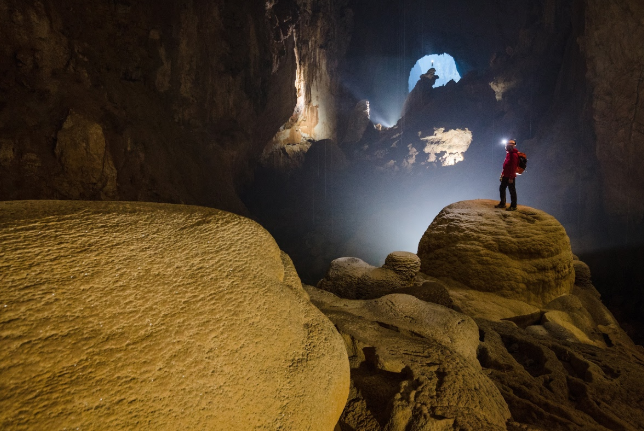
When Is the Son Doong Cave Expedition Available?
Due to the unpredictable weather and flooding risks, Son Doong Cave expeditions are only available during the dry season, from January to August. Tours typically do not operate between September and December, as heavy rains make access to the cave too dangerous.
The official expedition season starts in January when conditions are cooler and the terrain is drier, making for a more comfortable trekking experience. The season runs until August, when the weather becomes increasingly hot and humid, and occasional early monsoon rains may start affecting travel.
Pros & Cons of Different Travel Seasons
The best time to visit Son Doong depends on personal preferences regarding weather conditions, temperature tolerance, and trekking difficulty.
Visiting between January and March offers the most pleasant climate, with cool temperatures and lower humidity. The jungle is lush and vibrant, and river crossings are manageable due to lower water levels. However, this period is also the most popular, meaning limited availability for tours and the need to book months in advance.
From April to June, temperatures rise, making trekking more physically demanding. The advantage of this period is fewer tourists, increasing the chances of securing a spot on an expedition. The cave’s interior remains cool, providing a refreshing contrast to the heat outside.
July and August mark the final months of the expedition season. The landscape is still beautiful, but increasing humidity and occasional heavy rains can make certain sections of the trek more challenging. This period is ideal for those who don’t mind the heat and are looking for a later-season adventure before the tours close for the year.
Choosing the best time to visit Son Doong Cave depends on balancing favorable weather conditions with personal comfort and availability. Regardless of the season, the experience of exploring the world's largest cave remains an unforgettable adventure.
How to Prepare for the Son Doong Cave Adventure?
Visiting Son Doong Cave is a once-in-a-lifetime experience, but preparation is key to ensuring a safe, comfortable, and unforgettable journey. From packing the right gear to getting physically ready, here’s how to prepare for the adventure of a lifetime.
Packing List - Essentials for the Expedition
The Son Doong expedition requires careful packing, as trekkers will be hiking through dense jungle, crossing rivers, and exploring a massive cave system. Here’s a list of essentials to bring on your journey:
- Backpack: A durable, waterproof backpack to carry all your gear. A 50-60L capacity backpack should be sufficient.
- Clothing: Light, moisture-wicking clothing that can handle the jungle heat and humidity. Long sleeves and pants are recommended to protect against insects.
- Footwear: Sturdy, waterproof hiking boots with good grip for slippery surfaces, as well as a pair of sandals or camp shoes for when you're not trekking.
- Rain Gear: A waterproof jacket and poncho to protect you during the unpredictable weather conditions.
- Headlamp: A reliable headlamp with extra batteries for exploring the cave.
- Water Bottle: A durable, refillable water bottle to stay hydrated throughout the trek.
- Snacks: High-energy snacks like trail mix, energy bars, and dried fruit.
- Personal Items: A camera, personal hygiene items, and a first-aid kit.
- Sunscreen & Insect Repellent: Essential for protecting yourself against the sun and jungle insects.
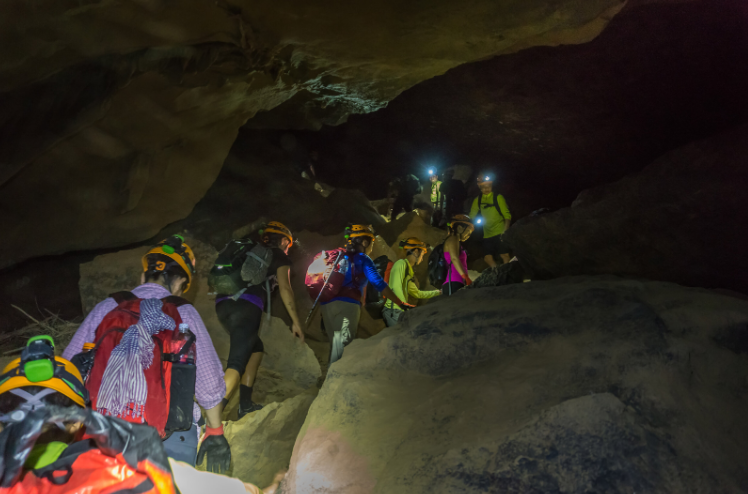
Fitness & Training Tips for First-Time Trekkers
Given the challenging nature of the Son Doong trek, physical fitness is a crucial part of preparation. While the trek is not technically difficult, the long hours of walking and the tough terrain can be demanding. Here’s how to get physically prepared:
- Cardio Training: Focus on improving cardiovascular endurance with activities like running, cycling, and hiking. Aim for at least 30-45 minutes of moderate cardio, 3-4 times a week.
- Strength Training: Incorporate strength training into your routine, especially for your legs and core. Squats, lunges, and step-ups are excellent exercises to prepare for the uneven terrain.
- Hiking Practice: If possible, go on regular hikes with a backpack to get used to carrying weight while walking uphill, through rocky paths, or over uneven ground.
- Endurance: Simulate the trek by walking for several hours straight. Start with shorter walks and gradually increase your distance, mimicking the conditions of the Son Doong trek.
- Flexibility: Stretching and yoga will help improve your flexibility and mobility, reducing the risk of injuries during the trek.

Safety Guidelines & Things to Know Before You Go
Son Doong Cave is an incredible adventure, but it comes with inherent risks. To ensure your safety and make the most of your expedition, keep the following guidelines in mind:
- Travel with a Licensed Guide: The Son Doong Cave expedition must be done with an experienced and licensed guide. The cave is remote and can be dangerous without proper navigation.
- Stay Hydrated: Due to the humid environment and physical exertion, it’s crucial to drink plenty of water throughout the trek.
- Listen to Your Guides: Always follow the instructions of your guide, especially during technical sections such as river crossings, rappelling, and ladder climbing.
- Know Your Limits: While the trek is designed for people with moderate fitness, it’s important to recognize your limits. If you feel unwell or exhausted, communicate with your guide immediately.
- Respect the Environment: Son Doong is a fragile ecosystem. Do not disturb wildlife, leave no trace of your presence, and follow the “Leave No Trace” principles.
- Pack Light, But Smart: Keep your gear as light as possible without compromising on essentials. Remember, you’ll be carrying everything yourself, and every extra kilogram adds weight to your load.
Preparing for the Son Doong Cave adventure involves more than just physical fitness—it’s about packing the right gear, ensuring safety, and respecting the environment. By taking these preparations seriously, you’ll be ready for one of the most extraordinary experiences of your life.
How Much Does It Cost to Visit Son Doong Cave?
Exploring Son Doong Cave is a once-in-a-lifetime adventure, but it comes with a high price tag. The cost of the expedition reflects the exclusivity, logistical challenges, and environmental conservation efforts required to preserve this natural wonder. Here’s a breakdown of the expenses and some budget-friendly alternatives for adventure seekers.
Why Is the Son Doong Cave Tour Expensive?
The Son Doong Cave expedition is not a standard tourist attraction-it’s a highly regulated, multi-day journey into a remote wilderness. Several factors contribute to the high cost of the tour:
- Limited Permits: To protect the fragile ecosystem, only a restricted number of visitors are allowed each year. This exclusivity raises the cost per person.
- Expert Guides & Porters: A single expedition requires a team of professional guides, safety experts, porters, cooks, and even cave specialists to ensure a safe and smooth experience.
- Logistics & Equipment: Everything from food to camping gear must be carried into the cave, adding to the operational costs.
- Environmental Conservation: A portion of the fee goes toward preserving the cave and supporting sustainable tourism initiatives in Phong Nha-Ke Bang National Park.
- Specialized Safety Measures: The challenging terrain requires safety equipment, including harnesses, ropes, and helmets, which are provided as part of the tour.

A Breakdown of the Tour Costs
A Son Doong Cave expedition typically costs between $3,000 and $3,500 per person. Here’s what this price covers:
- Guided Expedition: Includes an expert English-speaking guide, safety assistants, and a team of porters.
- Accommodation & Meals: All meals, snacks, and drinks are provided during the tour, along with camping gear for overnight stays inside the cave.
- Safety Equipment: Helmets, harnesses, trekking poles, and first-aid support are included.
- Transportation: Pick-up and drop-off services from Dong Hoi or Phong Nha are usually part of the package.
- National Park Fees: The cost helps fund conservation projects and maintain the protected area.
Alternative Caving Adventures for Budget Travelers
For those who want to experience Vietnam’s stunning caves without the hefty price tag, several alternatives offer incredible adventures at a fraction of the cost:
- Hang En Cave: Often considered a mini version of Son Doong, Hang En features a massive chamber and a natural beach inside. Tours start at around $300-$400 per person.
- Tu Lan Cave System: A thrilling multi-day adventure involving swimming, climbing, and trekking through stunning caves. Prices range from $200-$500, depending on the duration.
- Phong Nha Cave & Paradise Cave: These accessible caves within Phong Nha-Ke Bang National Park offer breathtaking formations and underground rivers, with entrance fees under $15.
While Son Doong is an unparalleled experience, Vietnam’s diverse cave systems offer plenty of opportunities for adventure, making it possible for travelers of all budgets to explore the underground wonders of this beautiful country.
Other Must-Visit Caves Near Son Doong
While Son Doong Cave is the crown jewel of Phong Nha-Ke Bang National Park, the region is home to many other spectacular caves that are worth exploring. Whether you're looking for a challenging trek, an underground river adventure, or an easier cave experience, these alternatives offer breathtaking scenery and unique experiences.
Hang En Cave - The Third Largest Cave in the World
Hang En is often overshadowed by Son Doong, but it is a remarkable destination in its own right. As the third-largest cave in the world, it boasts an enormous main chamber, a stunning natural beach inside, and a dramatic entrance framed by lush jungle.
To reach Hang En, visitors must embark on a two-day trek through dense forests, cross rivers, and navigate rugged terrain before arriving at the cave’s entrance. Once inside, campers are treated to an unforgettable overnight stay, with the cave’s vast ceiling and shimmering turquoise pools creating an almost otherworldly setting. The trek is challenging but far more accessible than Son Doong, making it a great alternative for those seeking adventure without the extreme difficulty or cost.
.png)
Tu Lan Cave System - A Hidden Gem in Phong Nha
The Tu Lan Cave System consists of over 10 caves, each offering a unique blend of trekking, swimming, and caving. This network of caves is known for its underground rivers, towering waterfalls, and dramatic limestone formations, making it an exhilarating choice for adventure seekers.
Unlike Son Doong, which requires an expensive guided tour, Tu Lan is more affordable and offers various expedition options, ranging from one-day tours to multi-day treks. Some caves require swimming through underground river passages, adding an extra thrill to the experience. The journey to Tu Lan also includes trekking through remote jungles and scenic valleys, making it an immersive adventure into Vietnam’s wild landscapes.
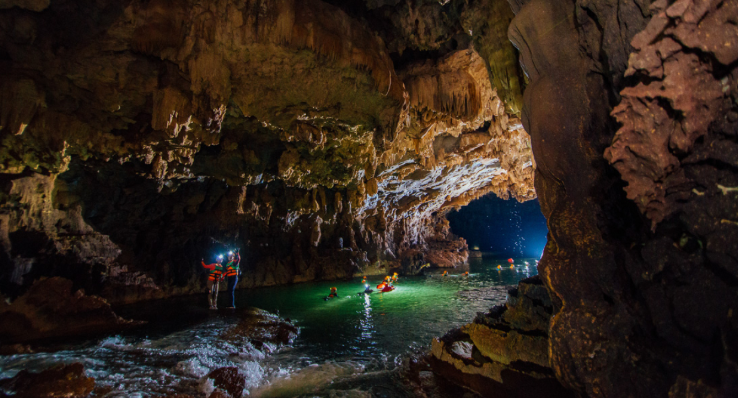
Paradise Cave - A Stunning Alternative for Non-Trekkers
For those who prefer a more accessible yet equally breathtaking cave, Paradise Cave (Động Thiên Đường) is a must-visit. Stretching over 31 kilometers, it is one of the longest dry caves in Asia and features an awe-inspiring array of stalactites and stalagmites illuminated by soft golden lighting.
Unlike Son Doong or Hang En, visiting Paradise Cave requires no trekking experience. A well-maintained wooden walkway allows visitors to explore the first one kilometer of the cave, making it suitable for travelers of all ages. For those looking for a deeper adventure, guided tours offer access to more remote sections, where visitors can explore hidden chambers and underground rivers.

How to Get to Son Doong Cave?
Son Doong Cave is located in Phong Nha-Ke Bang National Park, a remote area in Quang Binh Province, Central Vietnam. Since the cave is deep within the jungle and requires a guided expedition, reaching the starting point involves multiple travel steps. Whether you’re coming from Hanoi, Ho Chi Minh City, or another part of Vietnam, here’s how to plan your journey.
Travel Routes from Hanoi & Ho Chi Minh City
Most visitors start their journey to Son Doong from either Hanoi or Ho Chi Minh City, as these two major cities offer the best domestic and international flight connections.
From Hanoi
By Air: The fastest option is to take a 1-hour flight from Hanoi to Dong Hoi Airport (VDH). From there, it’s a 45-kilometer drive to Phong Nha town, the gateway to the national park.
By Train: Vietnam’s Reunification Express offers an overnight train from Hanoi to Dong Hoi, taking 8-10 hours. This is a scenic and comfortable option.
By Bus: Sleeper buses run daily from Hanoi to Phong Nha, taking around 9-10 hours. While affordable, the ride can be long and bumpy.
From Ho Chi Minh City
By Air: A direct flight from Ho Chi Minh City to Dong Hoi Airport takes 1.5 hours. This is the most convenient option.
By Train: The train from Ho Chi Minh City to Dong Hoi takes over 20 hours, making it a long but scenic journey.
By Bus: Direct buses from Ho Chi Minh City to Phong Nha are rare, and the journey takes over 24 hours, making this the least recommended option.

Best Ways to Reach Phong Nha-Ke Bang National Park
Once you arrive in Dong Hoi, you’ll need to travel to Phong Nha town, which is the main base for Son Doong Cave expeditions.
- Private Car/Taxi - The fastest and most comfortable way to get from Dong Hoi to Phong Nha (about 1 hour). Taxis and private transfers can be arranged through your hotel or tour operator.
- Local Bus - A more budget-friendly option, local buses run from Dong Hoi to Phong Nha, but schedules can be inconsistent.
- Motorbike Rental - For adventurous travelers, renting a motorbike is a scenic way to explore the region, though it requires experience with Vietnam’s road conditions.
Where to Stay Before & After the Expedition?
Since Son Doong expeditions require early morning departures, most visitors stay in Phong Nha town before starting their journey. There are accommodation options for all budgets, from hostels to eco-lodges and boutique hotels.
- Budget: Phong Nha Backpacker Hostel - A great choice for solo travelers and backpackers, offering dorms and private rooms.
- Mid-Range: Phong Nha Lake House Resort - A peaceful lakeside retreat with comfortable rooms and great amenities.
- Luxury: Chay Lap Farmstay & Resort - A high-end eco-resort offering a relaxing stay in nature with excellent service.
After the expedition, many travelers choose to spend an extra night in Phong Nha to relax before heading back to Dong Hoi, Hanoi, or Ho Chi Minh City. Whether you’re looking for adventure or a quiet retreat, Phong Nha offers a variety of options to make your journey to Son Doong smooth and enjoyable.
Photography Tips for Capturing Son Doong’s Beauty
Son Doong Cave is a photographer’s dream, with its massive chambers, misty underground rivers, and lush jungle illuminated by natural skylights. However, cave photography presents unique challenges, including low light conditions, high humidity, and difficult terrain. Whether you're using a professional camera or a smartphone, these tips will help you capture the cave’s stunning beauty.
Best Camera Gear for Cave Photography
Since Son Doong is a dark and vast environment, choosing the right gear is crucial for getting clear, high-quality shots.
- Camera: A DSLR or mirrorless camera with manual settings is ideal. Models with high ISO performance and a wide dynamic range work best for low-light conditions.
- Lens: A wide-angle lens (e.g., 16-35mm or 14-24mm) helps capture the massive scale of the cave. If you want to focus on details, bring a 50mm or 85mm prime lens for sharp shots of stalactites and rock formations.
- Tripod: A sturdy but lightweight tripod is essential for long-exposure shots, as it helps stabilize your camera in dim lighting.
- Lighting: A powerful headlamp or external flash can enhance visibility and illuminate cave textures without washing out details.
- Waterproof Protection: The cave’s humidity and underground river crossings require dry bags and silica gel packs to protect your gear from moisture.

Lighting Challenges & How to Overcome Them
One of the biggest obstacles in cave photography is the lack of natural light, which can make photos look too dark or grainy. Here’s how to adjust your settings:
- Increase ISO - Use a high ISO (1600-6400) for better exposure, but be mindful of noise levels.
- Use a Slow Shutter Speed - A long exposure (1-10 seconds) allows more light to enter, but a tripod is necessary to avoid blurring.
- Adjust Aperture - A wide aperture (f/2.8-f/4) helps capture more light, but too wide of an aperture may reduce depth of field.
- Use Artificial Light Strategically - LED lights, torches, or headlamps can illuminate subjects, but avoid overexposure by diffusing the light.
Iconic Spots Inside Son Doong for Breathtaking Shots
Son Doong’s size and beauty offer numerous photography hotspots that highlight its unique landscape. Some of the must-capture locations include:
- The Entrance of Son Doong - A dramatic shot of the towering entrance, often shrouded in mist.
- The Hand of Dog - A massive stalagmite shaped like a dog’s paw, one of the cave’s most famous formations.
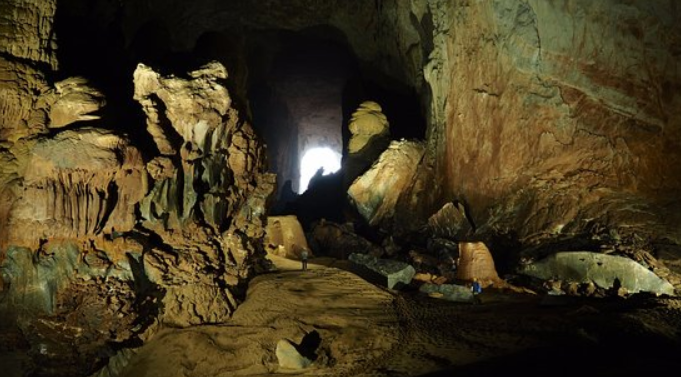
- The Underground Jungle - Lush greenery growing inside a doline, where sunlight streams in to create a magical scene.
- The Great Wall of Vietnam - A 90-meter-high calcite wall near the cave’s exit, one of the most challenging sections to climb.
- The Underground River - Capture reflections of the cave walls and the ethereal blue water illuminated by headlamps.
With the right preparation and techniques, you can take jaw-dropping photos that showcase Son Doong’s breathtaking beauty while preserving the natural darkness and mystery of the world’s largest cave.
Conclusion - Why Son Doong Cave Should Be on Your Bucket List
Son Doong Cave is more than just a tourist destination—it’s an extraordinary journey into one of the last untouched wonders of the natural world. Whether you’re an adventure seeker, a nature lover, or a passionate traveler, visiting Son Doong is an experience that will leave you in awe.
A Once-in-a-Lifetime Adventure in Vietnam
Few places on Earth offer the kind of raw, untouched beauty that Son Doong provides. From trekking through dense jungles and crossing underground rivers to standing beneath colossal caverns illuminated by natural skylights, every step inside Son Doong is an unforgettable moment. The cave’s sheer size and breathtaking formations make it a once-in-a-lifetime adventure that rivals some of the world’s most famous natural wonders.
Beyond its beauty, Son Doong offers a true exploration experience-one that requires physical endurance, teamwork, and a willingness to embrace the unknown. Unlike traditional tourist spots, where visitors follow paved paths, Son Doong demands real adventure, making it all the more rewarding for those who embark on the journey.
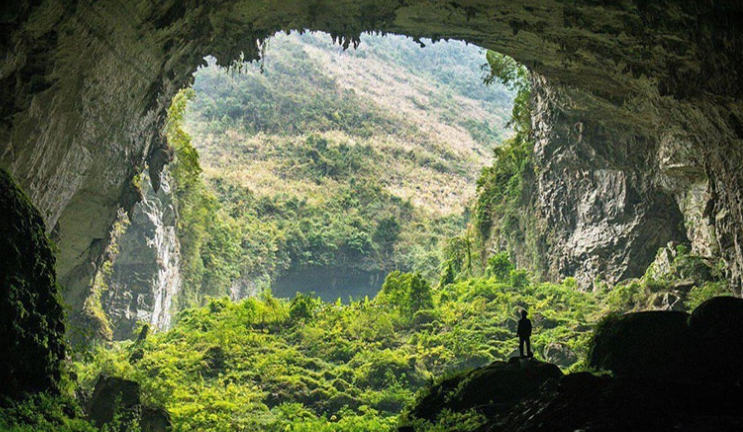
Son Doong’s Role in Conservation & Ecotourism
Son Doong is not just a marvel of nature; it is also a symbol of sustainable tourism and environmental conservation. The cave was opened to the public with strict regulations to preserve its fragile ecosystem and minimize human impact.
Each year, only a limited number of visitors are allowed inside, ensuring that the cave remains as pristine as it was when it was first discovered. The tour operators, local porters, and guides work together to maintain a zero-impact approach, removing waste and leaving no trace behind.
Additionally, Son Doong has played a major role in promoting ecotourism in Vietnam, providing jobs for local communities and encouraging responsible travel. By visiting Son Doong, travelers contribute to both nature conservation and the economic growth of the region.
Final Travel Tips for an Unforgettable Experience
To make the most of your Son Doong adventure, keep these final tips in mind:
- Plan Early - Son Doong tours are limited and sell out quickly, so book at least a year in advance.
- Train for the Trek - Prepare for the physical demands by practicing long-distance hikes and endurance exercises.
- Pack Smart - Bring essential gear like moisture-wicking clothing, durable hiking boots, and a waterproof camera.
- Respect Nature - Follow the guides’ instructions and help preserve the cave’s pristine condition.
- Embrace the Challenge - Son Doong is not just a trip; it’s an expedition. Stay open-minded, push your limits, and enjoy the journey.
Exploring Son Doong Cave is an extraordinary privilege, offering a rare glimpse into a world few have seen. For those seeking adventure, wonder, and a deeper connection with nature, this journey into Earth’s largest cave is an experience that will stay with you forever.










